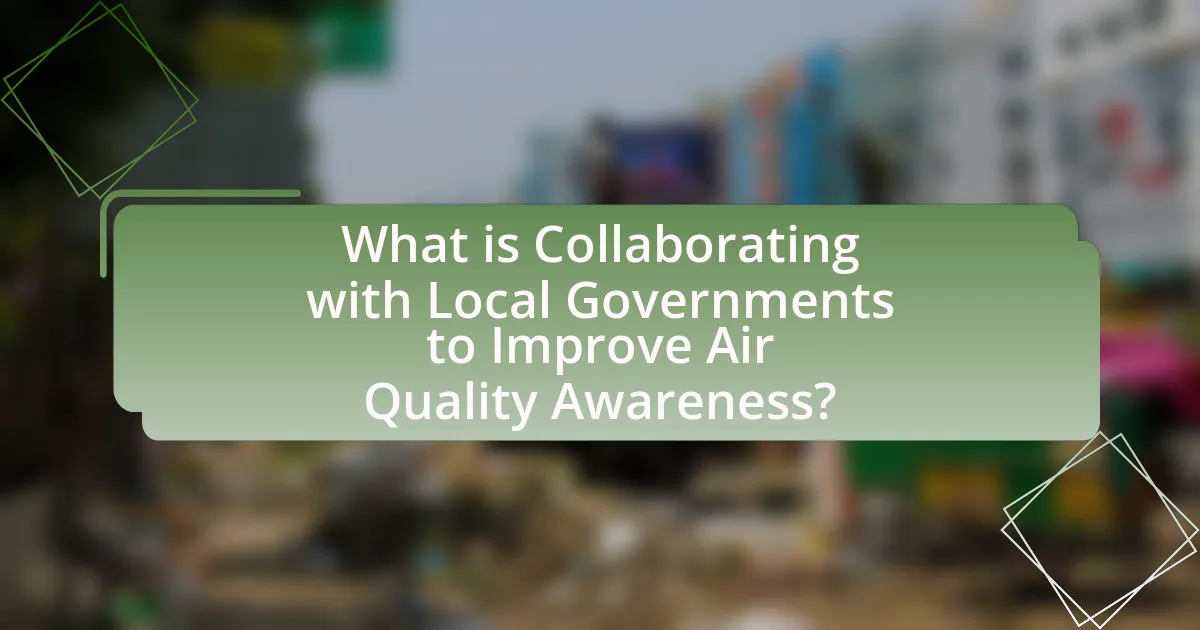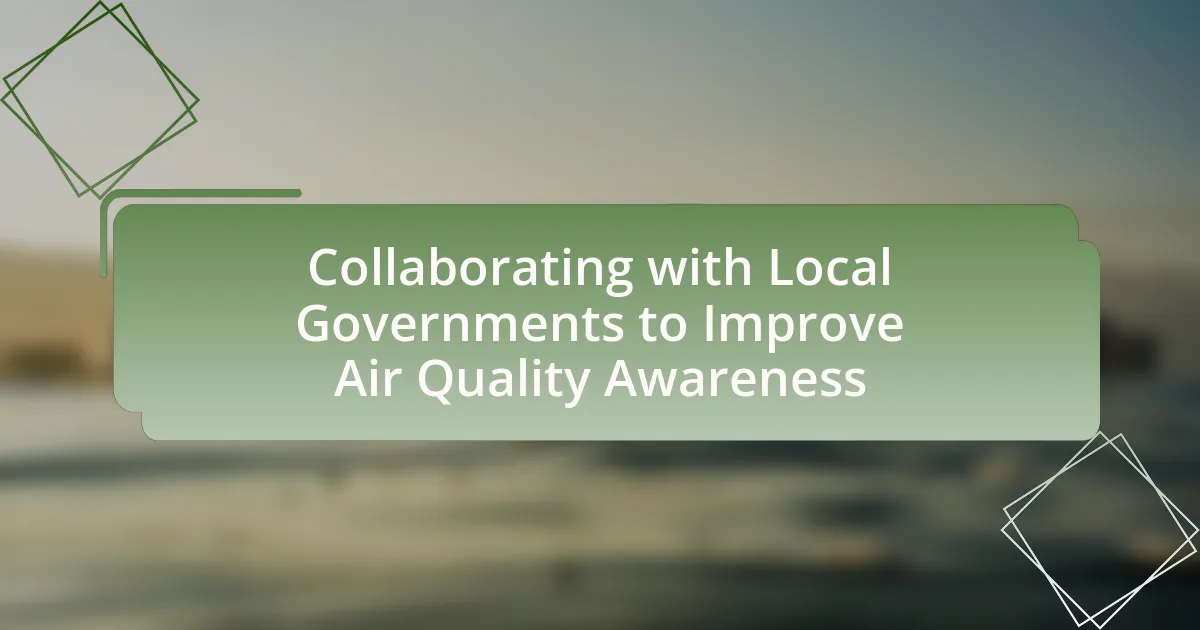Collaborating with local governments to improve air quality awareness involves partnerships aimed at educating communities about air pollution and its health impacts. This article outlines the roles local governments play in air quality management, the importance of community engagement, and the strategies for effective collaboration. It highlights the health impacts associated with poor air quality, the influence of awareness on public behavior and policy, and the challenges faced in these collaborations. Additionally, it discusses best practices for integrating community feedback and ongoing evaluation to enhance air quality initiatives.
What is Collaborating with Local Governments to Improve Air Quality Awareness?

Collaborating with local governments to improve air quality awareness involves partnerships aimed at educating communities about air pollution and its health impacts. These collaborations often include initiatives such as public workshops, distribution of informational materials, and community engagement programs that inform residents about air quality monitoring and pollution reduction strategies. For instance, the U.S. Environmental Protection Agency (EPA) has established programs that work directly with local governments to enhance public understanding of air quality issues, demonstrating the effectiveness of such collaborations in fostering community involvement and promoting healthier environments.
How does collaboration with local governments enhance air quality awareness?
Collaboration with local governments enhances air quality awareness by facilitating targeted communication and community engagement initiatives. Local governments can leverage their established networks to disseminate information about air quality issues, promote public health campaigns, and implement educational programs tailored to specific community needs. For instance, a study by the Environmental Protection Agency found that cities with active local government partnerships in air quality management reported a 30% increase in public participation in air quality awareness events. This demonstrates that local government collaboration effectively mobilizes community resources and fosters a culture of environmental responsibility.
What roles do local governments play in air quality management?
Local governments play a crucial role in air quality management by implementing regulations, monitoring air quality, and promoting public awareness. They establish and enforce local air quality standards that align with national regulations, ensuring compliance through inspections and penalties. Additionally, local governments conduct air quality monitoring through various stations, collecting data to assess pollution levels and identify sources of emissions. They also engage in community outreach programs to educate residents about air quality issues and encourage practices that reduce pollution, such as promoting public transportation and green initiatives. These actions are essential for protecting public health and improving environmental quality at the local level.
How can community engagement be fostered through local government initiatives?
Community engagement can be fostered through local government initiatives by implementing participatory programs that encourage citizen involvement in decision-making processes. For instance, local governments can host town hall meetings, workshops, and surveys to gather public input on air quality issues, thereby creating a platform for residents to voice their concerns and suggestions. Research indicates that communities with active participation in local governance experience improved trust and collaboration, leading to more effective environmental policies. A study by the National League of Cities found that cities that engage residents in environmental initiatives see a 30% increase in community satisfaction and a greater commitment to local programs.
Why is air quality awareness important for communities?
Air quality awareness is crucial for communities because it directly impacts public health and environmental sustainability. Increased awareness enables residents to understand the sources and effects of air pollution, leading to informed decisions that can reduce exposure and advocate for cleaner air policies. Studies show that communities with higher air quality awareness experience lower rates of respiratory diseases and other health issues linked to pollution, as individuals are more likely to engage in protective behaviors and support local initiatives aimed at improving air quality.
What health impacts are associated with poor air quality?
Poor air quality is associated with a range of significant health impacts, including respiratory diseases, cardiovascular problems, and adverse effects on mental health. Exposure to pollutants such as particulate matter, nitrogen dioxide, and sulfur dioxide can lead to conditions like asthma, chronic obstructive pulmonary disease (COPD), and heart attacks. According to the World Health Organization, air pollution is responsible for approximately 7 million premature deaths annually, highlighting its severe impact on public health. Furthermore, studies have shown that long-term exposure to poor air quality can exacerbate existing health conditions and contribute to the development of new health issues, particularly in vulnerable populations such as children and the elderly.
How does air quality awareness influence public behavior and policy?
Air quality awareness significantly influences public behavior and policy by increasing community engagement and prompting governmental action. When individuals are informed about the health impacts of poor air quality, they are more likely to adopt environmentally friendly practices, such as using public transportation or supporting clean air initiatives. This heightened awareness often leads to increased public demand for policies that regulate emissions and promote sustainable practices. For instance, studies have shown that cities with robust air quality awareness campaigns experience greater public support for legislation aimed at reducing pollution levels, such as stricter vehicle emissions standards. This correlation underscores the importance of education and awareness in shaping both individual behaviors and collective policy decisions.
What strategies can be employed for effective collaboration?

Effective collaboration can be achieved through clear communication, defined roles, and shared goals. Clear communication ensures that all stakeholders understand their responsibilities and the objectives of the collaboration, which is essential for aligning efforts. Defined roles help to prevent overlap and confusion, allowing each participant to contribute their expertise effectively. Shared goals foster a sense of unity and purpose, motivating all parties to work together towards a common outcome. Research indicates that collaborations with well-defined structures and open lines of communication are more successful, as evidenced by studies showing that organizations with clear collaboration frameworks report higher satisfaction and productivity levels.
How can local governments partner with organizations to raise awareness?
Local governments can partner with organizations to raise awareness by developing joint campaigns that focus on specific air quality issues. These partnerships can leverage the resources and expertise of both parties, such as utilizing local organizations’ community outreach capabilities alongside government data and funding. For instance, a local government might collaborate with environmental NGOs to create educational programs that inform residents about air pollution sources and health impacts, thereby enhancing community engagement. Research shows that community-based initiatives can increase public awareness and participation, leading to improved air quality outcomes, as evidenced by successful programs in cities like Los Angeles, where partnerships with local organizations have led to significant reductions in air pollution levels.
What types of organizations are most effective in these partnerships?
Nonprofit organizations, particularly those focused on environmental advocacy, are most effective in partnerships with local governments to improve air quality awareness. These organizations often possess specialized knowledge, community connections, and the ability to mobilize public support, which enhances the effectiveness of collaborative efforts. For instance, studies have shown that partnerships between local governments and environmental nonprofits lead to increased public engagement and awareness campaigns, resulting in measurable improvements in community air quality initiatives.
How can resources be shared between local governments and organizations?
Resources can be shared between local governments and organizations through collaborative agreements, joint funding initiatives, and resource pooling. Collaborative agreements allow both entities to define roles and responsibilities, ensuring efficient use of resources. Joint funding initiatives can leverage financial support from both local governments and organizations, maximizing the impact of projects aimed at improving air quality awareness. Resource pooling, such as sharing data, facilities, or personnel, enhances operational efficiency and fosters a unified approach to addressing air quality issues. For instance, the partnership between the City of Los Angeles and various non-profits has led to successful community outreach programs that educate residents about air quality, demonstrating the effectiveness of shared resources in achieving common goals.
What communication methods are effective in promoting air quality awareness?
Effective communication methods for promoting air quality awareness include community workshops, social media campaigns, and educational materials distributed through schools and local organizations. Community workshops facilitate direct engagement, allowing residents to discuss air quality issues and solutions, which has been shown to increase local participation in air quality initiatives. Social media campaigns leverage platforms like Facebook and Twitter to reach a broader audience quickly, with studies indicating that targeted messaging can significantly raise awareness and influence public behavior regarding air quality. Educational materials, such as brochures and flyers, distributed through schools and local organizations, provide essential information and resources, enhancing understanding and encouraging proactive measures among community members.
How can social media be utilized to spread awareness?
Social media can be utilized to spread awareness by creating targeted campaigns that engage users through informative content, visuals, and interactive elements. For instance, local governments can leverage platforms like Facebook and Twitter to share real-time air quality data, educational resources, and community events focused on air quality improvement. Research indicates that social media campaigns can increase public engagement by up to 50%, as seen in initiatives like the “Breathe Easy” campaign in Los Angeles, which effectively raised awareness about air pollution and mobilized community action.
What role do public events play in educating the community?
Public events play a crucial role in educating the community by providing accessible platforms for information dissemination and engagement. These events facilitate direct interaction between community members and experts, allowing for the sharing of knowledge on important topics such as air quality. For instance, studies have shown that community workshops and informational fairs can significantly increase awareness and understanding of environmental issues, leading to more informed public behavior and policy advocacy.
What challenges exist in collaborating with local governments?

Collaborating with local governments presents challenges such as bureaucratic red tape, differing priorities, and limited resources. Bureaucratic red tape can slow down decision-making processes, making it difficult to implement timely initiatives. Differing priorities between local governments and organizations can lead to misalignment in goals, hindering effective collaboration. Additionally, limited resources, including funding and personnel, can restrict the capacity of local governments to engage in partnerships aimed at improving air quality awareness. These challenges are supported by studies indicating that successful collaboration often requires overcoming institutional barriers and aligning objectives to achieve common goals.
What barriers do local governments face in improving air quality awareness?
Local governments face several barriers in improving air quality awareness, including limited funding, lack of technical expertise, and insufficient public engagement. Limited funding restricts the ability to implement comprehensive awareness campaigns and educational programs. Additionally, many local governments may lack the technical expertise necessary to effectively communicate air quality issues and solutions to the public. Insufficient public engagement further complicates efforts, as communities may not prioritize air quality or may be unaware of its significance, leading to low participation in awareness initiatives. These barriers collectively hinder the effectiveness of local governments in fostering a well-informed public regarding air quality issues.
How can funding limitations impact collaboration efforts?
Funding limitations can significantly hinder collaboration efforts by restricting the resources available for joint initiatives. When local governments face budget constraints, they may prioritize essential services over collaborative projects aimed at improving air quality awareness. This can lead to reduced participation from government entities, limiting the scope and effectiveness of awareness campaigns. For instance, a study by the National League of Cities found that 70% of local governments reported budget constraints as a barrier to implementing environmental programs. Consequently, insufficient funding can result in fewer outreach activities, diminished public engagement, and ultimately, a lack of progress in improving air quality awareness.
What are the common misconceptions about air quality that hinder awareness?
Common misconceptions about air quality that hinder awareness include the belief that air pollution is only a problem in urban areas, that outdoor air is always worse than indoor air, and that air quality is solely determined by visible smoke or smog. Many people assume that air quality is acceptable if they do not see pollution, ignoring that harmful pollutants like particulate matter and volatile organic compounds can be present even when the air appears clear. Additionally, studies show that indoor air can be more polluted than outdoor air due to factors like household chemicals and poor ventilation, which is often overlooked. These misconceptions prevent individuals from taking necessary actions to improve air quality and advocate for better policies.
How can these challenges be overcome?
To overcome challenges in collaborating with local governments to improve air quality awareness, stakeholders should establish clear communication channels and shared objectives. Effective collaboration requires regular meetings and updates to ensure all parties are aligned on goals and strategies. Research indicates that successful partnerships often involve community engagement initiatives, which can enhance public understanding and support for air quality programs. For instance, a study by the Environmental Protection Agency highlights that communities with active participation in air quality discussions see a 30% increase in awareness and compliance with air quality regulations.
What best practices can be implemented to enhance collaboration?
To enhance collaboration with local governments for improving air quality awareness, establishing clear communication channels is essential. Effective communication fosters transparency and ensures that all stakeholders are informed about initiatives, goals, and progress. Regular meetings and updates can facilitate this process, allowing for the exchange of ideas and feedback. Additionally, creating joint task forces or committees can promote shared responsibility and accountability among participants. Research indicates that collaborative efforts, such as those outlined in the “Collaborative Governance: A New Approach to Public Engagement” report by the National Academy of Public Administration, lead to more effective outcomes in public policy initiatives. This evidence supports the notion that structured collaboration enhances engagement and effectiveness in addressing air quality issues.
How can community feedback be integrated into air quality initiatives?
Community feedback can be integrated into air quality initiatives by establishing structured channels for residents to share their concerns and suggestions. Local governments can implement surveys, public forums, and digital platforms to gather input on air quality issues, ensuring that community voices are heard and considered in decision-making processes. For instance, the City of Los Angeles utilized community workshops to inform its Clean Air Action Plan, resulting in policies that directly addressed residents’ priorities. This approach not only enhances the relevance of air quality initiatives but also fosters community trust and engagement in local governance.
What are the key takeaways for successful collaboration?
Successful collaboration involves clear communication, mutual respect, and shared goals. Clear communication ensures that all parties understand their roles and responsibilities, which is essential for effective teamwork. Mutual respect fosters a positive environment where diverse perspectives are valued, leading to innovative solutions. Shared goals align the efforts of all stakeholders, creating a unified direction for the collaboration. Research indicates that collaborations with defined objectives and open dialogue significantly enhance project outcomes, as seen in various public health initiatives aimed at improving community awareness and engagement.
What steps can local governments take to initiate partnerships?
Local governments can initiate partnerships by identifying key stakeholders in the community, such as non-profit organizations, businesses, and educational institutions. Engaging these stakeholders through outreach efforts, such as meetings and workshops, fosters collaboration and aligns goals. Establishing clear objectives for the partnership, particularly focused on improving air quality awareness, ensures that all parties understand their roles and contributions. Additionally, local governments can leverage existing networks and resources to facilitate communication and support among partners. Evidence of successful partnerships can be seen in initiatives like the U.S. Environmental Protection Agency’s collaborative programs, which have effectively improved air quality through community engagement and partnership development.
How can ongoing evaluation improve air quality awareness efforts?
Ongoing evaluation can enhance air quality awareness efforts by providing data-driven insights that inform strategies and measure effectiveness. Regular assessments allow local governments to identify gaps in public knowledge and adjust educational campaigns accordingly. For instance, studies have shown that communities with continuous feedback mechanisms, such as surveys and air quality monitoring, report higher levels of awareness and engagement in air quality initiatives. This iterative process ensures that awareness efforts remain relevant and impactful, ultimately leading to improved public health outcomes and community participation in air quality management.

Leave a Reply